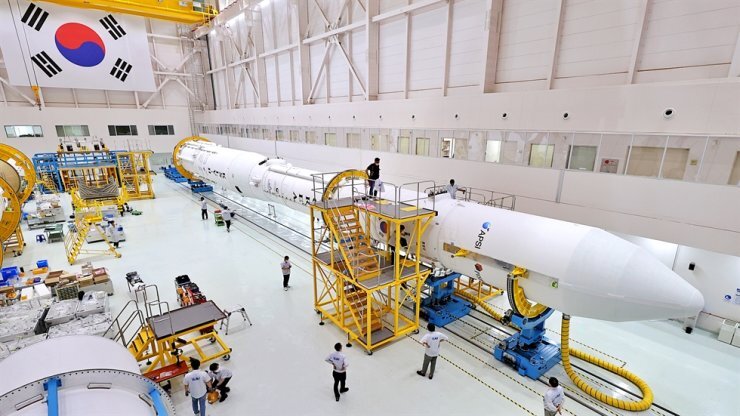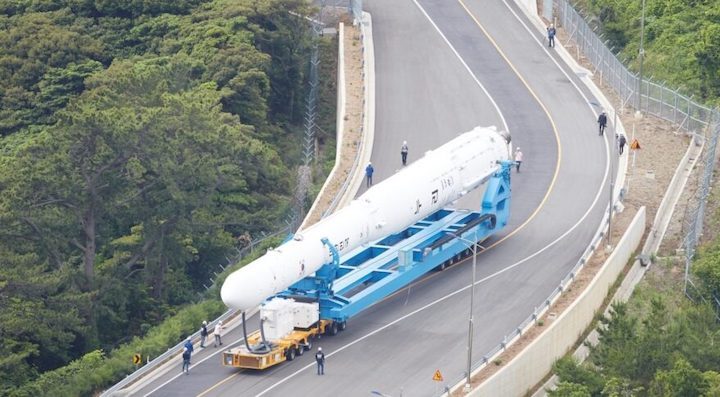14.06.2022

This photo shows the fully assembled Nuri rocket, also known as KSLV-II, at the Naro Space Center in the country's southern coastal village of Goheung, June 12. Courtesy of the Korea Aerospace Research Institute
Korea's state-run Korea Aerospace Research Institute (KARI) was carrying out final preparations Monday ahead of this week's second attempt to send multiple satellites into orbit.
Nuri, also known as KSLV-II (Korea Space Launch vehicle), is scheduled to be transported to the launch pad and erected vertically Tuesday at the Naro Space Center in the country's southern coastal village of Goheung one day ahead of the launch.
In its first attempt in October, Korea's first locally developed launch vehicle successfully flew to a target altitude of 700 kilometers but failed to put a dummy satellite into orbit as its third-stage engine burned out earlier than expected.
Last month, the science ministry set June 15 as the second launch date for Nuri.
Jang Young-soon, head of KARI's launcher system development team, said that the three-stage space rocket, which weighs 200 tons and measures 47.2 meters in height, has been fully assembled and was going through a final electrical system inspection.
Ahead of the second launch, Nuri underwent reinforcements of an anchoring device of the helium tank inside the third-stage oxidizer tank.
In October, the helium tank in the third-stage rocket fell off due to increased buoyancy during the flight and eventually caused the engine to shut off prematurely, according to a governmental committee report.
Engineers have added about 9 kilograms of reinforcements to the third-stage rocket to avoid such problems and said the augmentation is unlikely to affect the rocket's performance, Jang said in a recent online press conference.
A factor that could potentially affect the schedule is the weather, as authorities forecast a 60 percent chance of rain in the area Tuesday afternoon. Although the rocket itself is sealed to prevent water from entering, a large amount of rain could cause logistics problems.
Rain is not expected on launch day, but Jang said wind conditions are also a determining factor in the success of the launch. According to KARI, average surface wind speed must remain below 15 meters per second during the entirety of the process to ensure a successful launch.
The launch has been tentatively set at 4 p.m., but the exact time will be determined Wednesday depending on space conditions and sunspot explosions.
Unlike the October launch, which carried a single dummy satellite, Nuri this time will be loaded with a 180-kilogram performance verification satellite to test the rocket's capabilities and four separate cube satellites developed by four universities for academic research purposes.
"The most important mission (of the verification satellite) is testing the rocket's (satellite) injection capacity," Ahn Sang-il, a senior researcher at KARI's satellite and space exploration systems engineering team, said.
Korea plans to conduct four additional Nuri launches by 2027 as part of efforts to further advance the country's space program. (Yonhap)
Quelle: The Korea Times
+++
Nuri rocket launch postponed to Thursday due to wind

Nuri rocket is being loaded onto a transportation vehicle on Monday at Naro Space Center in Goheung, South Jeolla Province. (Joint Press Corp.)
The launch of homegrown rocket Nuri will be delayed by one day to Thursday due to windy weather at the launch site, the Ministry of Science and ICT said Tuesday, a day before the space rocket was to be launched.
It is the second space rocket to be launched after the first blastoff last October failed to put a dummy satellite into orbit.
Due to the bad weather, the government and state-run Korea Aerospace Research Institute have pushed the transportation of the rocket to Wednesday, and the actual launch to Thursday.
“Currently, the wind is strong at Naro Space Center (in Goheung, South Jeolla Province), and there is the possibility of wind growing much stronger. So we have decided to postpone the launch date to secure the safety of staff in the field,” the ministry said in a statement.
When the rocket is delivered to the launch pad, engineers have to make the rocket stand still using a launching device and inject electric power and engine fuel. But strong winds and rainy weather can compromise their safety, a KARI official said.
Authorities expect the rocket setup to go as planned on Wednesday, when weather at the launch site improves.
The Korea Meteorological Administration said low pressure in the southern region will head east on Tuesday, after which winds will subside and rain will stop in the overall southwestern region of the Korean Peninsula.
“Although there might be a few rain showers on Wednesday in the region, we forecast it would not critically hinder the rocket transportation to the launch pad,” a KMA official said.
Should the rocket launch be delayed again Thursday, the takeoff could still take place from Friday to June 23, officials said.
The KARI has completed assembly of the first and second stages of the three-stage rocket, which weighs 200 metric tons and measures 47.2 meters in height, and said it fixed technical glitches that led to the failure last time.
If the rocket reaches orbit, South Korea will become the seventh in the world to succeed in the development and launch of a satellite greater than 1 ton, following Russia, the US, Europe, China, Japan and India.
Quelle: The Korea Herald
----
Update: 19.06.2022
.
South Korean rocket’s second launch rescheduled for June 21

KSLV-2 is seen being rolled out to the launch pad at the Naro Space Center in Goheung, South Jeolla Province, June 15. Credit: Korea Aerospace Research Institute
SEOUL, South Korea — The second launch of South Korea’s first domestically built rocket is set for June 21, a delay of a week due to strong winds and a technical glitch.
“We convened a meeting of the launch management committee and decided to pursue the second launch on June 21,” Kwon Hyun-joon, a senior science ministry official, said June 17 in a live-streamed media briefing.
Kwon said the kerosene and liquid oxygen-fueled three-stage rocket KSLV-2 was lying horizontally in a hangar at the Naro Space Center, after a malfunctioning sensor in the first-stage booster was replaced with a new one.
The rocket will be rolled back to the launch pad June 20, he said.
KSLV-2’s second launch was initially set for June 15, with a backup launch window spanning June 16-23.
However, it was delayed to the following day due to strong winds — and delayed again after engineers found a problem with a level sensor, installed inside the oxidizer tank of the rocket’s first-stage booster, during a final pre-launch checkup at the launch pad.
According to the Korea Aerospace Research Institute (KARI), readings on the malfunctioning sensor remained static when the tank was being filled. The rocket was pulled off the launch pad and rolled back to the hangar June 15, and went through a checkup to identify the cause of the problem.
KARI said engineers identified the problematic part within the sensor and replaced it, and Kwon said they also found no other problems after inspecting the rest of the rocket.
Kwon noted that the rescheduled launch date could be subject to change depending on weather conditions.
The Naro Space Center is expecting a 60-70% chance of rain on June 21, according to the Korea Meteorological Administration.
KSLV-2 is South Korea’s first domestically developed space rocket, capable of putting up to 1,500 kilograms of payload to low Earth orbit. Its first-stage booster has a cluster of four KRE-075 engines, the second-stage has a single KRE-075 engine and the third-stage has a KRE-007 engine.
The rocket reached its intended altitude during its maiden flight Oct. 21, but its third-stage engine shut down 46 seconds early, releasing its 1,500-kilogram dummy payload at less than orbital speed.
The dummy payload fell back to Earth south of Australia, according to KARI. The premature engine shutdown was later blamed on improperly anchored helium tanks inside the upper stage.
In the upcoming launch, the rocket will carry five satellites — a 180-kilogram performance test satellite and four smaller satellites developed by domestic universities.
Besides the upcoming mission, South Korea plans to conduct four additional KSLV-2 launches by 2027 as part of efforts to further advance the country’s space rocket program.
Quelle: SN
